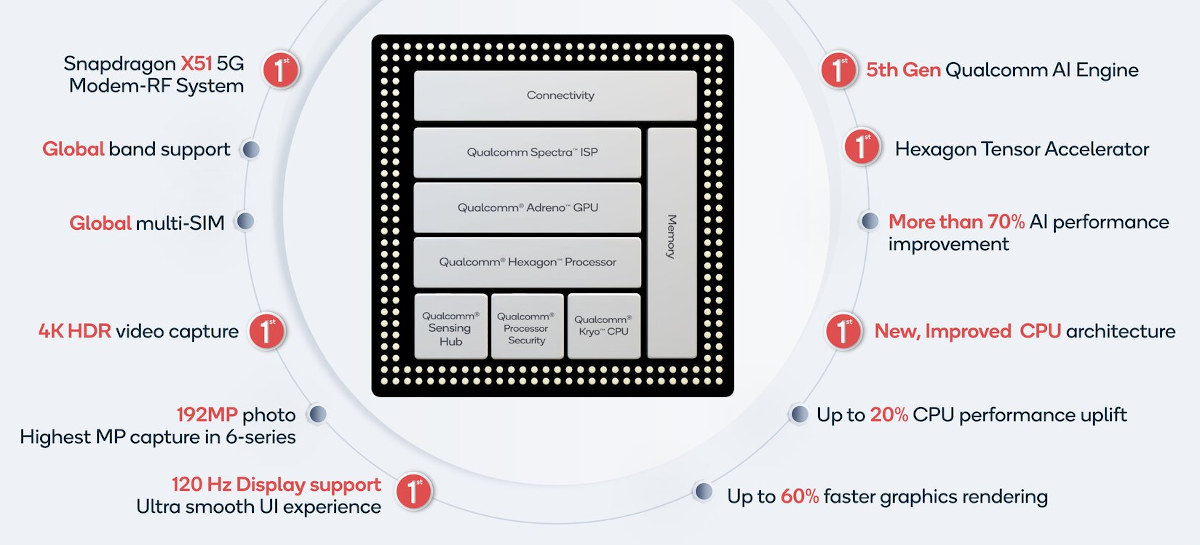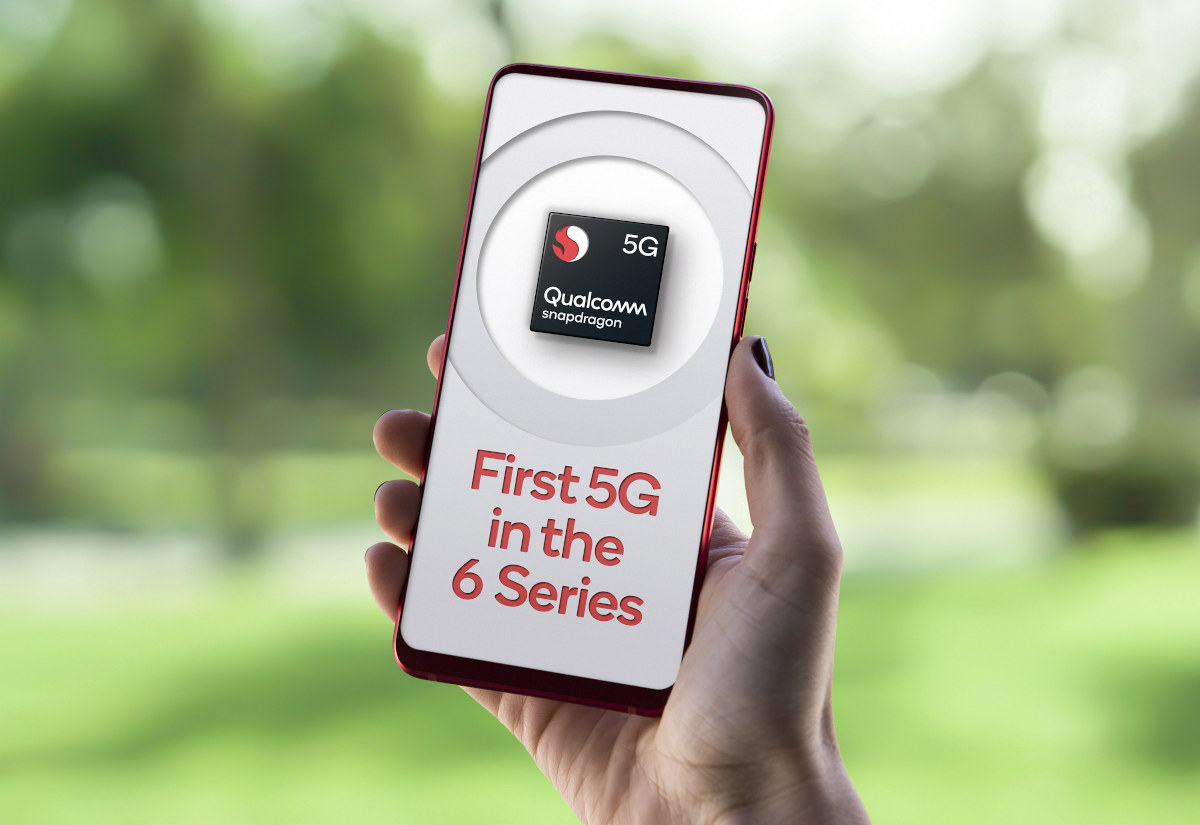Qualcomm launched Snapdragon 855, the company’s first 5G mobile processor, in December 2018, before following up the next year with Snapdragon 865, 765, and 765G 5G mobile platforms still targetted to higher-end and premium smartphones.
Qualcomm has now introduced its first 5G mobile SoC part of the mid-range Snapdragon 600-series with Snapdragon 690 5G octa-core processor featuring Cortex-A77 and Cortex-A53 cores, and a Snapdragon X51 5G modem delivering up to 2.5 Gbps download speed.
Qualcomm Snapdragon 690 5G (SM6350) specifications:
- CPU – Octa-core QualcommKryo 560 CPU @ up to 2.0 GHz, specifically 2x Cortex 77 cores @ 2.0 GHz and 6x Cortex-A55 cores @ 1.7 GHz
- GPU – Qualcomm Adreno 619L GPU with support for OpenCL 2.0 FP, OpenGL ES 3.2, Vulkan 1.1, and DX12 APIs
- DSP – 2x Qualcomm Hexagon 692 with Qualcomm Hexagon Vector eXtensions (HVX), Hexagon Tensor Accelerator, Qualcomm Hexagon Scalar Accelerator
- Qualcomm Sensing Hub – Ultra-low-power hub for audio, voice, and sensors
- Memory Support – 2×16-bit LPDDR4x up to 1866 MHz, 8 GB RAM max
- Storage – It must be confidential, but UFS is probably supported.
- Display
- On-Device Display – up to FHD+ @ 120 Hz
- External Display – up to QHD @ 60Hz
- HDR10+, HDR10, up to 10-bit color depth, Rec2020 color gamut
- Camera
- Qualcomm Spectra 355L image signal processor, 14-bit, 2x Image Signal Processor (ISP)
- Dual Camera up to 16 MP+32MP at 30 fps
- Single Camera up to 192 MP
- 4K HDR video capture
- Slow Motion Video Capture: 720p @ 240 FPS
- Video
- HDR10, HLG, HEVC, Rec. 2020 color gamut video capture, up to 10-bit color depth video capture
- Codec – H.265 (HEVC), H.264 (AVC), VP8, VP9
- Audio
- Qualcomm Aqstic audio codec up to Qualcomm WCD9385
- Qualcomm Aqstic smart speaker amplifier up to Qualcomm WSA8815
- Qualcomm Aqstic audio technology
- Qualcomm Hexagon Voice Assistant Accelerator
- Connectivity
- Cellular
- Qualcomm Snapdragon X51 5G Modem-RF System
- Technology – HSPA, WCDMA, TD-SCDMA, CDMA 1x, EV-DO, GSM/EDGE, LTE including CBRS support, 5G NR
- Spectrum – Dynamic Spectrum Sharing (DSS), sub-6 GHz
- 5G sub-6 GHz specs – 100 MHz bandwidth, 4×4 MIMO
- Peak Speed
- Download – 1.2 Gbps (LTE), 2.5 Gbps (5G)
- Upload – 210 Mbps (LTE), Up to 660 Mbps (5G)
- Multi-SIM features: Global 5G multi-SIM
- Performance Enhancement Technologies – Qualcomm 5G PowerSave, Qualcomm Smart Transmit technology, Qualcomm Wideband Envelope Tracking, Qualcomm Signal Boost adaptive antenna tuning
- FastConnect 6200 Subsystem
- 802.11a/b/g/n, 802.11ac Wave 2, 802.11ax Wi-Fi 6 with 2×2 MIMO, 8-stream sounding (for 8×8 MU-MIMO), WPA3 security support, Target Wake Time
- Bluetooth 5.1 with aptX Adaptive Audio, Qualcomm TrueWireless Stereo
- Near Field Communications (NFC)
- GNSS – Beidou, Galileo, GLONASS, dual-frequency GNSS, NavIC, GPS, GNSS, QZSS, SBAS
- Cellular
- USB – USB 3.1, USB-C via DisplayPort Alt Mode support
- Security
- Biometric Authentication (Fingerprint, Iris, Voice, Face)
- Features – Camera Security, Crypto Engine, Key Provisioning Security, Malware Protection, Qualcomm Content Protection, Qualcomm Mobile Security, Qualcomm Processor Security, Qualcomm Trusted Execution Environment, Secure Boot, Secure Token
- Charging – Qualcomm Quick Charge 4+ technology
- Process Technology – 8 nm

The CPU, GPU, DSP, and sensing hub complex is referred to as the “Qualcomm Artificial Intelligence (AI) Engine” since all blocks are leveraged for AI acceleration, with the company stating a 70% uplift in AI performance compared to the previous generation Snapdragon 675 processor. Snapdragon 690 also get a 20% boost in CPU performance, and up to 60% faster graphics rendering.
Mid-range 5G smartphones based on Snapdragon 690 are expected in H2 2020 from companies including HMD Global, LG Electronics, Motorola, SHARP, TCL, and Wingtech. Visit the product page for additional details.

Jean-Luc started CNX Software in 2010 as a part-time endeavor, before quitting his job as a software engineering manager, and starting to write daily news, and reviews full time later in 2011.
Support CNX Software! Donate via cryptocurrencies, become a Patron on Patreon, or purchase goods on Amazon or Aliexpress






It always amazes me what advanced technology we have today but unfortunately we as Makers will never be able to play with that chip (would probably way to complex anyway) because Qualcomm doesn’t release any documentation whatsoever.
What maker project would you use a chip like this in if it was accessible?
Building a custom Linux SBC for example
And I’m completely sure you could release a board with that soc paired with 4GB of memory under $100 with the 5g slot available natively, not $200+ for a snapdragon 4xx.
But that’s how mobile business works, and they make incredible efforts day after day to make sure they artificially keep you away from improving them in order to be able to charge you extra when they release something improved by them. I despise mobile ecosystem more than mac ecosystem because of the way they are creating it, and that’s really sad.
>But that’s how mobile business works, and they make
>incredible efforts day after day to make sure they artificially
You’re crazy. If you sign their NDA and place an order for millions of dollars of chips they’ll be happy to sell them to you. You not having millions of dollars to order chips is not their underhand way of keeping you out of the business.
To be honest I think there’s a lot more to factor in here than just not being able to get the docs. Let’s say you can get the documentation, qualcomm will send you sample parts etc… Well this isn’t a 80s micro processor that needs a bit of SRAM, clock, reset and power to make it work.
You are going to need electronics skills that are far beyond most makers, board layout skills that are again far beyond most makers, access to professional equipment,.. a lot of money to burn on multiple spins of boards with lots of layers with very fine tolerances and very specific construction. TL;DR; you will need the engineering department of a mobile phone/SoM vendor.
I’m not saying it’s impossible but even if you could do it you probably wouldn’t bother because you’d have the sense to realise making a bespoke board instead of buying something pre-made with the right specs is foolish.
On the other hand if you want to embed little ARM SoCs that can just about run useful linux setups onto cheap 4 layer boards from JLCPCB that’s doable right now.
Qualcomm has launched a board for robotics projects based on an SoC similar to Snapdragon 865. It’s sold for $485 (pre-order).
https://www.cnx-software.com/2020/06/19/qualcomm-robotics-rb5-platform-targets-the-development-of-5g-and-ai-enabled-robots/